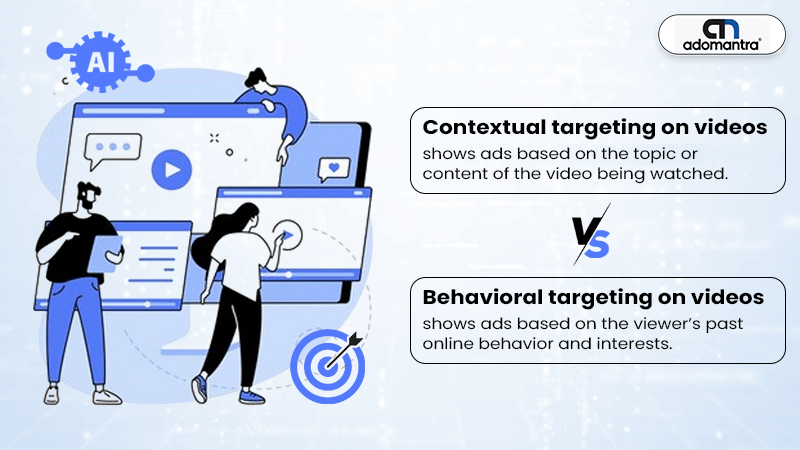
Contextual Targeting vs. Behavioral Targeting on Videos: What Should You Choose?
Video ads are everywhere today. From social media to streaming platforms, they grab attention and tell stories. But showing the right video ad to the right person is a big challenge. This is where contextual targeting and behavioral targeting come in. Both help marketers reach audiences, but in very different ways.
So, if you’re wondering which to pick for your video campaigns, you’re not alone. Let’s break down how contextual targeting vs behavioral targeting on videos work. Then you can decide which fits your goals best!
What Is Contextual Targeting on Videos?

Contextual targeting in video advertising means showing ads based on the content of the video or the surrounding page.
For example, if someone is watching a cooking show, an ad for kitchen gadgets or meal delivery might appear. If the video is about fitness, ads for workout gear or health supplements might show.
How It Works
- The system analyzes the video’s topic, keywords, or category.
- Ads related to that topic are then served alongside the video.
- No personal data or browsing history is needed.
Why Choose Contextual Targeting for Video?
- Privacy-friendly: It respects user privacy since it does not track individuals.
- Relevant ads: Ads match what the viewer is watching right now, which can increase engagement.
- Cookie-free: Works well as third-party cookies are phased out.
- Brand safety: You control the context where your ads appear, avoiding mismatched content.
Contextual targeting is ideal when privacy matters or when you want to reach new audiences based on video content themes.
What Is Behavioral Targeting on Videos?

Behavioral targeting for video ads uses a viewer’s past behavior to decide which ads to show. It looks at things like videos watched, searches made, and interactions with ads or websites.
For example, if someone watches a lot of sports videos and recently searched for running shoes, they might see an ad for a new sneaker brand.
How It Works
- Data is collected through cookies, device IDs, or user accounts.
- Algorithms analyze viewer habits and preferences.
- Ads are personalized based on this data to increase relevance and chances of conversion.
Why Choose Behavioral Targeting for Video?
- Highly personalized: Ads match a viewer’s specific interests.
- Better retargeting: It brings back viewers who showed interest but did not convert.
- Higher conversion rates: Personal ads tend to drive more action.
However, behavioral targeting relies on tracking and data, which may be limited by privacy laws and cookie restrictions.
Contextual Targeting vs Behavioral Targeting on Videos: Key Differences
|
Aspect |
Contextual Targeting |
Behavioral Targeting |
|
Basis |
Video content and context |
Viewer’s past behavior and data |
|
Data Used |
None or minimal personal data |
Browsing history, preferences |
|
Privacy Friendliness |
Very high |
Moderate, depends on consent |
|
Personalization Level |
General relevance |
High personalization |
|
Cookie Dependence |
No |
Yes, or alternative IDs |
|
Best For |
Brand safety, privacy, broad reach |
Conversions, retargeting, precise targeting |
Which One Should You Choose for Video Ads?

The choice depends on your campaign goals and your audience. Here’s a quick guide:
- Choose contextual targeting if:
- You want to respect user privacy fully.
- You are targeting new viewers who don’t have prior data.
- Your brand values appear alongside relevant video content.
- You want to avoid issues with cookie restrictions.
- Choose behavioral targeting if:
- You want to deliver highly personalized ads.
- Your goal is to retarget interested viewers to boost conversions.
- You have consent and good data to support personalization.
- You want to optimize for sales or sign-ups.
Many advertisers use a mix of both to cover all stages of the customer journey. Contextual targeting brings in new eyes, while behavioral targeting helps close the deal.
The Future of Video Ad Targeting
Privacy rules and cookie changes are shifting video ad targeting. Contextual targeting is becoming more advanced with AI, which helps understand video content deeply. Behavioral targeting is evolving too, relying more on first-party data and privacy-safe tech.
Smart marketers will use both contextual targeting vs behavioral targeting on videos to build trust and stay effective. It’s about balancing relevance with respect.
Final Thoughts
When it comes to video ads, there is no single “best” way. Both contextual and behavioral targeting have their place. Contextual targeting keeps ads relevant and privacy-safe. Behavioral targeting offers personalization and better conversion potential.
Adomantra is already an expert in combining these strategies to help brands connect with their audiences while navigating today’s privacy-focused landscape. With data-driven, respectful approaches, we deliver strong results and build lasting trust.
If you want to boost your video ad performance and grow your business, Adomantra can guide you to the right targeting strategy with confidence.
Frequently Asked Questions About Contextual Targeting vs. Behavioral Targeting on Videos
Q1. What is the difference between behavioral and contextual targeting?
A1. Here is how behavioral and contextual targeting differ:
- Behavioral targeting shows ads based on a person’s past actions, like websites they visited or things they searched for. It looks at their online behavior over time.
- Contextual targeting shows ads based on the content of the page a person is currently viewing. It matches ads to the topic or theme of that page, not the person’s history.
Q2. What is a key advantage of using contextual targeting over behavioral targeting?
A2.One big advantage is privacy. Contextual targeting does not track a person’s past behavior or collect personal data. It only looks at the content of the page to show relevant ads. This makes it better for respecting user privacy.
Q3. Is behavioral targeting ethical?
A3.Behavioral targeting can raise ethical concerns because it collects and uses personal data without people always knowing or agreeing. Some feel it invades privacy. However, if done transparently and with permission, it can be ethical. The key is being clear about data use and protecting users’ privacy.
Q4. What is the contextual behavioral approach?
A4.The contextual behavioral approach combines both methods: it looks at the content someone is viewing right now and their past behavior to show ads. This way, ads are relevant both to the current context and the person’s interests.
Q5. What is an example of contextual marketing?
A5. Imagine you are reading an article about hiking. You see an ad for hiking boots or outdoor gear on that page. This is contextual marketing because the ad matches the topic of the article, making it more useful and relevant for you.







